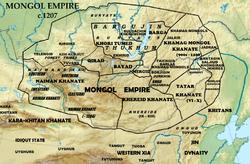Merkit
This articleneeds additional citations forverification.(December 2011) |
Merkit Three Mergids | |||||||||||
|---|---|---|---|---|---|---|---|---|---|---|---|
| 11th century–1200 | |||||||||||
 Mongol Empirec.1207 | |||||||||||
| Status | nomadicconfederacy | ||||||||||
| Capital | Not specified | ||||||||||
| Religion | Shamanism | ||||||||||
| Government | Elective monarchy | ||||||||||
| Khan | |||||||||||
| Historical era | Post-classical Central Asia | ||||||||||
• Established | 11th century | ||||||||||
• Disestablished | 1200 | ||||||||||
| |||||||||||
| Today part of | Mongolia Russia(Buryatia) | ||||||||||
| History of Mongolia |
|---|
 |
TheMerkit(literally"skillful/wise ones";Mongolian:ᠮᠡᠷᠬᠢᠳ; Мэргид,romanized:Mergid;simplified Chinese:Miệt nhi khất;traditional Chinese:Miệt nhi khất;pinyin:Miè'érqǐ) was one of the five majortribal confederations(khanlig) of probablyMongol[1][2][3][4]orTurkic origin[5][6][note 1]in the 12th centuryMongolian Plateau.
The Merkits lived in the basins of theSelengaand lowerOrkhon River(modern southBuryatiaandSelenge Province).[8]After a struggle of over 20 years, they were defeated in 1200 byGenghis Khanand were incorporated into theMongol Empire.
Etymology
[edit]The wordMerged(мэргэд) is a plural form derived from theMongolianwordmergen(мэргэн), which means both "wise" and "skillful marksperson", as in adept in the use of bow and arrow. The word is also used in many phrases in which it connotes magic, oracles, divination, augury, or religious power. Mongolian language has no clear morphological or grammatical distinction between nouns and adjectives, somergenmay mean "a sage" as much as "wise" or mean "skillful" just as much as "a master."Mergedbecomes plural as in "wise ones" or "skillful markspeople". In the general sense,mergenusually denotes someone who is skillful and wise in their affairs.[citation needed]
Three Mergeds
[edit]The Mergeds were a confederation of three tribes, inhabiting the basin of the Selenga and Orkhon Rivers.
- The Uduyid Merkits lived in Buur-kheer, near the lower Orkhon River;
- The Uvas Merkits lived in Tar, between the Orkhon and Selenge Rivers;
- The Khaad Merkits ( "Kings" Merkits) lived in Kharaji-kheer, on the Selenge River.
Ethnic relations
[edit]The Merkits were related to the Mongols,Naimans,Keraites,andKhitan people.[9]
Conflict with Genghis Khan
[edit]Temüjin'smotherHoelun,originally from theOlkhonud,had been engaged to the Merkit chiefYehe Chileduby 1153. She was abducted by Temüjin's fatherYesugei,while being escorted home by Yehe Chiledu.
In turn, Temüjin's new wifeBörtewas kidnapped by Merkit raiders from their campsite by the Onon river around 1181 and given to one of their warriors. Temüjin, supported by his brother (not blood-related)Jamukhaand hiskhan etseg('khan father')Toghrulof theKeraites,attacked the Merkit and rescued Börte within the year. The Mergids were dispersed after this attack. Shortly thereafter she gave birth to a son namedJochi.Temüjin accepted paternity but the question lingered throughout Jochi's life. These incidents caused a strong animosity between Temüjin's family and the Merkits. From 1191 to 1207, Temujin fought the Merkits five times.
By the time he had united the other Mongol tribes and received the titleGenghis Khanin 1206, the Mergids seem to have disappeared as an ethnic group. Those who survived were likely absorbed by other Mongol tribes (Oirats,Buryats,Khalkhas) and others who fled to theKipchaksmixed with them. In 1215–1218,JochiandSubutaicrushed the remnants of them under their former leader Toghta Beki's family. The Mongols clashed with theKankalisor the Kipchaks because they had sheltered the Merged.
Genghis Khan had a Mergedkhatun(queen) named Khulan. She died while Mongol forcesbesieged Ryazanin 1236. In 1236, during theMongol invasion of Volga Bulgaria,a body of the Merkit was found in the area of land dominated by theBulgarandKipchak.
Late Mergeds
[edit]A few Mergeds achieved prominent position among the Mongols, but they were classified as Mongols in Mongolian society.Great KhanGuyuk's beloved khatunOghul Qaimish,who was a regent from 1248–1251, was a Merged woman. The traditionalistBayanand his nephewToqto'aserved asgrand chancellorsof theYuan dynasty.After the fall of the Yuan dynasty, they were a clan of a banner in theNorthern Yuan dynasty.
Notes
[edit]References
[edit]- ^History of the Mongolian People's Republic. — Nauka Pub. House, Central Dept. of Oriental Literature, 1973. — p. 99.
- ^Jeffrey Tayler. Murderers in Mausoleums: Riding the Back Roads of Empire Between Moscow and Beijing.— Houghton Mifflin Harcourt, 2009. — p. 1. —ISBN9780547523828.
- ^Bertold Spuler. The Muslim world: a historical survey. — Brill Archive, 1969. — p. 118.
- ^Elza-Bair Mataskovna Gouchinova. The Kalmyks.— Routledge, 2013. — p. 10. —ISBN9781135778873.
- ^Soucek, Svat.A History of Inner Asia. — Cambridge University Press, 2000. — p. 104. —ISBN978-0521657044.
- ^Гурулёв С. А. Реки Байкала: Происхождение названий. – Иркутск: Восточно-Сибирское книжное издательство, 1989 – 122 с. ISBN 5-7424-0286-4
- ^Christopher P. Atwood – Encyclopedia of Mongolia and the Mongol EmpireISBN9780816046713,Facts on File, Inc. 2004.
- ^History of Mongolia, Volume II, 2003
- ^Weatherford, Jack (2005).Genghis Khan and the Making of the Modern World.Crown/Archetype. p. 12.ISBN978-0-307-23781-1.
